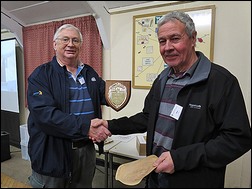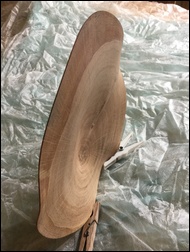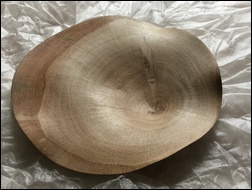Club Night Report
Wednesday 13th January 2016
Club Night Report for 13th January 2016 - observations by Vernon Hughes
 |
 |
 |
 |
 |
 |
 |
 |
 |
 |
 |
 |
 |
 |
 |
 |
Melvyn's weapons (whoops…. tools) on display then left the feeling that we might have been preparing for Agincourt. Although one passed round for inspection this time measured 50" in length, the overall impact seemed a little less fearsome, although almost without exception the handles were considerably longer than those commonly available. He mentioned use of tools 7ft in length! Melvyn's plan was to start with a thin-stemmed goblet and he showed a very fine example of one prepared earlier in Yew. For this demonstration his square section blank was wettish Beech - a timber that has reasonably good lateral strength. Refinement would not be the object this evening; his aim was to demonstrate techniques, tool design and use. He reminded us that he rarely uses chucks due inter alia to the time lost in preparing timber for mounting and the adjustments needed as work proceeds. He promptly mounted in just over a trice the (say 9" long) blank on a small faceplate using four screws with square-socket heads (Robertson screws) and without tailstock support. He would have preferred four more screw-holes and would therefore use longer screws than usual on this occasion. Back in his workshop in Somerset he uses faceplates drilled out with up to twelve screw positions. He had not brought any catalogues but could supply packs of No. 10 (ideal size) square socket screws upon request. They are so very convenient in use. Available in the UK via Square Screws - see: www.squarescrews.co.uk
Roughing down the square section blank was carried out with his famed 'nib gouge' which removed substantial layers of timber; and squaring off the end was done with the same tool. Melvyn spoke about the value of a variable speed facility and the wisdom of starting the roughing down process fairly slowly. As work progressed he explained/ demonstrated that the nib gouge provided six tools in one, and later on boring work increased that to seven. He sang the praises of Steinert VB36 lathes; of which he has three and remarked that they invariably run vibration free even when heavy cuts of ¼" to ½" were being sliced off in one pass. He advised that tools should be kept as finely sharp as possible and that use of a permanent marker pen to coat the bevel before starting to sharpen will, over time, teach the user how to sharpen efficiently and save time and a lot of metal. When the tool is offered to the grinding wheel keep checking the efficiency of contact by reference to the marker, and if necessary adjust the angle of presentation accordingly. Repeat as necessary. Attention was then paid to the working height of the grinder. The height should permit users to stand up straight and not to have to stoop or crouch. His own wheel-mounted grinder table used on the night demonstrated this to perfection. He uses wide Ruby grinding wheels sourced from 'The Toolpost', which now come in 80 and 60 grits. An earlier preferable 100 grit is no longer available. He demonstrated fine points about sharpening, particularly of the nib gouge, and how a well-sharpened tool, properly used, can produce the very finest of shavings. He also mentioned the value of a half-speed grinder and also demonstrated the movement (rock then roll) involved in sharpening the nib gouge. He had a bucket of water to hand for rapid cleaning of tools to which wet timber had stuck (See also the March 2013 Club Night Review). On another aspect of tool design and use it came as no surprise that there was considerable emphasis on the Irish grind (swept back wings) applied to some gouges.
When blank reduction to a cylinder was complete Melvyn plunged the nib gouge into the side of the blank at a point that indicated where the bottom of the goblet bowl would come. This plunge cut was increased in width towards the foot but not deep enough to weaken the overall strength of the blank, recognizing that detailed work on the bowl was still to come. Hollowing out was then undertaken starting with boring by nib gouge (starting just left of centre) followed by scooping out with a variety of tools but particularly one personally crafted at the grinder from a gouge (see photo). Scooping is achieved by pushing the handle away from the body. Before boring, Melvyn returned to a point made in 2013 about the use of collars for toolrest stems that ensured that toolrests are always set to a standard height appropriate to purpose. He had seen plastic piping used for this in America and (as also explained in the 2013 report) it is common in the Basque region (France) to see a specific collar kept alongside every tool ready for use.
External shaping of the goblet's bowl was completed before fine disciplined work was carried out in the thin-stem shaping phase. This was done in sweeping cuts starting at the blank's perimeter and curving down from the headstock end towards the completed goblet bowl. As the length of the stem grew steadily its shape was refined/ streamlined and the right hand was cupped round the bowl as necessary to steady it. With the hand removed occasionally the Beech timber stood up surprisingly well to the significant whipping effect of rotation but could not match the stability offered by Yew (said Melvyn). This patient, precise work was continued until the point for final foot shaping and parting off was reached. One of the exceptionally fine (2 mm wide?) parting tools was (almost unbelievably) fluted!
 |
 |
 |
 |
Conclusion: We had been in the hands of one unquestionably at the 'cutting edge' of knowledge about tool design, about timber characteristics, about the exact interface between metal and rotating timber and the consequences of contact there, and many other things as well. Some of our number will have been able to comprehend every detail of his conveyed knowledge, whilst others including the writer may never come to possess, let alone understand in some cases, a nib gouge, or an Irish grind or critically designed tools for a range of functions, or a grinding table on castors, or a VB36 lathe, etc., etc. Just for a moment we were given a fleeting glimpse of the reality of a parallel universe (who will tell Stephen Hawking?). We could not help but enjoy hearing about all these wonders and seeing the tools, equipment and principles in perpetual action throughout. We had been right royally entertained and applauded accordingly!
This month's Show and Tell theme was - An Open Theme - something you are particularly pleased with... This was well supported with a varied mix of items submitted on the table.
| This month's Show and Tell winner was Ken Crittle who entered a shallow dish. Ken's timber source was a 220 mm part seasoned log taken from his firewood pile. The log had the pith off centre - Ken turned an end grain, shallow dish to about 1 mm thickness. This was then left to dry to see what shape it ended up. Result: very interesting! |
 |
 |
 |
 |
